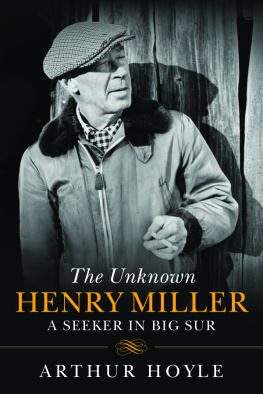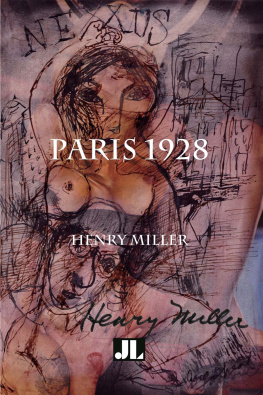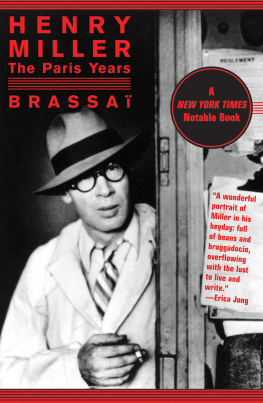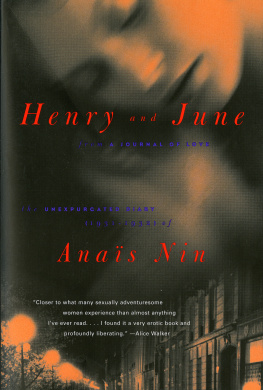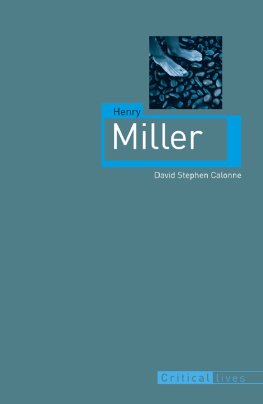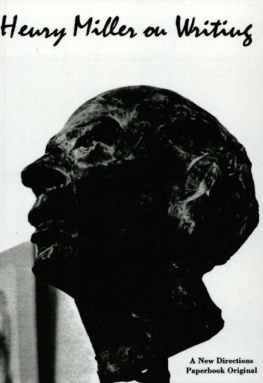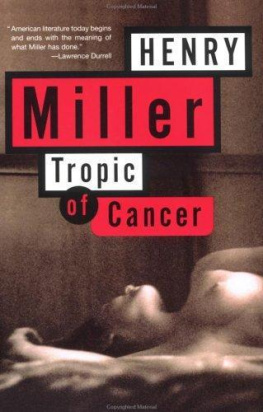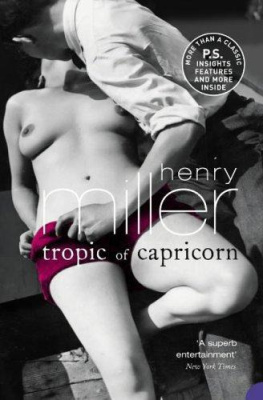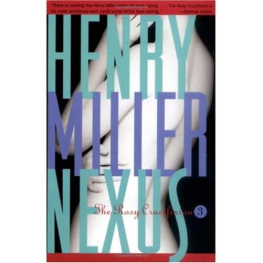Copyright 2014 by Arthur Hoyle
All Rights Reserved. No part of this book may be reproduced in any manner without the express written consent of the publisher, except in the case of brief excerpts in critical reviews or articles. All inquiries should be addressed to Arcade Publishing, 307 West 36th Street, 11th Floor, New York, NY 10018.
First Edition
Arcade Publishing books may be purchased in bulk at special discounts for sales promotion, corporate gifts, fund-raising, or educational purposes. Special editions can also be created to specifications. For details, contact the Special Sales Department, Arcade Publishing, 307 West 36th Street, 11th Floor, New York, NY 10018 or .
Arcade Publishing is a registered trademark of Skyhorse Publishing, Inc., a Delaware corporation.
Visit our website at www.arcadepub.com.
Visit the authors website at arthurhoyle.com
10 9 8 7 6 5 4 3 2 1
Library of Congress Cataloging-in-Publication Data
Hoyle, Arthur, 1941
The Unknown Henry Miller : a Seeker in Big Sur / Arthur Hoyle.
pages cm
ISBN 978-1-61145-899-2 (hardback)
1. Miller, Henry, 1891-1980. 2. Authors, American20th centuryBiography. 3. Big Sur (Calif.)Biography. I. Title.
PS3525.I5454Z696 2014
813.52dc23
[B]
2013046530
Printed in the United States of America
For Adrien, who loves to read
and
In loving memory of Alex and Ricardo
We whose names are hereunder written, being desirous to inhabit the town of Providence, do promise to submit ourselves, in active or passive obedience, to all such orders or agreements as shall be made for public good of the body, in an orderly way, by the major consent of the present inhabitants, masters of families incorporated together into a township, and others whom they shall admit unto the same, only in civil things.
Roger Williams, compact for the founding of the colony of Providence in present-day Rhode Island, 1636
A fitly born and bred race, growing up in right conditions of outdoor as much as indoor harmony, activity and development, would probably, from and in those conditions, find it enough merely to live and would, in their relations to the sky, air, water, trees, etc., and to the countless common shows, and in the fact of life itself, discover and achieve happinesswith Being suffused night and day by wholesome ecstasy, surpassing all the pleasures that wealth, amusement, and even gratified intellect, erudition, or the sense of art, can give.
Walt Whitman
I would say that it was on this rocktemporarily forgottenthat America was founded.
Henry Miller
C ONTENTS
I NTRODUCTION
W HY A NEW BIOGRAPHY OF H ENRY M ILLER, AND WHY NOW?
Henry Miller is an undeservedly neglected American author. Although the publication of his Paris books in the 1960s caused a national sensation, he remains unread by most Americans. And yet, Henry Miller was unique among twentieth-century American authors for making his own life experiencesall of them, from the scatological to the sublimethe raw material of his books. His aim as a writer was to use language to transform these life experiences into art and, through art, to transform himself. Art became for him the means for reaching the highest level of human attainment, self-realization. In the history of American literature, only his idol Whitman sang such a song of himself. But today, while Whitman is a fixture in the literary pantheon, Miller is largely unknown, excluded from the academic canon, rarely taught in colleges and universities, remembered, if at all, as the author of banned books that broke through the American and British censorship barriers. Perhaps his very uniqueness, his willingness to parade naked before us, has marginalized him; he refuses to fit into any recognizable American tradition. Does he embarrass us? Or perhaps shame us?
This biography was written to reposition Miller for a new generation of readers. It revisits Millers life and work to reveal the man and the artist at their point of intersection, language. The facts of Millers life have been thoroughly chronicled in three previously published biographies. But the facts of Millers life do not give us a true portrait of him. A true portrait emerges only when we witness Millers imagination at work, practicing the alchemical transmutation of the dross of his everyday experience into the gold of art. Millers alchemical apparatus was his mastery of the English language, which he used in a variety of styles and forms to express and reveal his complex and often contradictory character. It is as a stylist, a stylist of the self, that Miller distinguishes himself. No modern writer, not Faulkner, not Joyce, surpasses Millers ability to create a new imaginative reality out of words.
My portrait of Miller is drawn from his mature years as a writer, because only when he found his voice with Tropic of Cancer does the real Henry Miller come into view. It begins with his breakout in Paris during the 1930s, when he wrote the books whose originality and brilliance made him celebrated in Europe and whose obscenity made him notorious in America. It ends with his final breakthrough to the broad American readership denied him by the censors, the US publication of the Tropics and his major autobiographical saga, The Rosy Crucifixion . I have blended passages from Miller texts with letters he wrote and received to expose the intersection between his life and his art. His own words, and the words of those who knew him intimately, are the flesh of my portrait. The facts of his life are merely the skeleton.
Twenty years have elapsed since the last biographies of Miller were published. During this period, his reputation in America has continued to languish. For many commentators, the time of his relevance for American readers, the 1960s, has passed. But to regard Miller merely as the author of largely censorable books whose achievement was to liberate our standards of what words are permissible to appear in print is to diminish him by turning him into a historical curiosity and to miss his true significance.
Henry Millers voice and the message it carriesthe message of self-liberationare timeless. Although he writes in great detail about his life as an American living in the twentieth century, to locate him solely in conventional time and space and try to understand him in that context is to see him only partially. For Miller, the specifics of his time and place were merely a stepping-stone to a higher plane of reality, the realm of cosmic consciousness. Miller writes not as a citizen of America, or even the Earth, but as a member of the human race who inhabits the universe.
Miller distrusted biography and biographers because he believed their obsession with facts blinded them to the reality of the imagination, which he considered the only true reality. Nevertheless, he wrote several biographies himself: full-length studies of D. H. Lawrence and Arthur Rimbaud, shorter sketches of people, usually artists like himself, whom he admired. Commenting on The World of Lawrence he said, The only way to do justice to a man like that, is to give another creation. Not explain him, but prove by writing about him that one has caught the flame he tried to pass on. And that is what I have tried to do.

